Recent events are inviting and requiring organizations to engage in change at a pace previously regarded as impossible. Leaders and teams are faced with creating an array of strategies that are creative, represent innovation, and will result in sustainability and survival. For some (generally the minority), environmentally-imposed rapid change offers a necessary and exciting opportunity to innovate and iterate without some of the barriers or restrictions that were previously assumed. For others, change is challenging and can result in feelings of uncertainty and distress. Both views, and the gray in-between, are accurate and real. Knowing that people’s comfort can rest at these two poles or the infinite space between is critical when engaging in the change required to address the continued inequities and disparities in our society.
There is no shortage of leadership and change management theories to use when working within an organization or system. Critical in effecting change is understanding who you are as an organization and what approaches, actions, and activities are most congruent with both who you strive to be and what your organization intends to achieve. Working to promote equity, diversity, and inclusion must be infused into all of our efforts.
From my perspective, successful change efforts require a leader. Being “the leader” may be legitimized by role and positional authority, or it can be a designated or assumed role. While there is variability in environments, I believe that all people can be “the leader” and lead in place. While the scope and sphere may vary, every person can have self-determination, take responsibility, and assume ownership for effecting positive change. Every person can be forward thinking, aspirational, and inspirational – all required when working on change. Cynthia McCauley, Senior Fellow at the Center for Creative Leadership says that “there isn’t ‘a’ leader making leadership happen” (2014, p. 6). Similarly, I would argue that there isn’t “a” leader who will make change happen. Change is a collaborative process. Incumbent upon the authorized or designated leader of change is to inspire those around them and to make space for change to occur. Only through an adaptive, authentic, and inclusive process is change likely to be adopted and sustained. We must lean in to these opportunities and to contribute to evolving the systems and structures that impede our society.
Leaders of change are educators and facilitators. They must help people see and become energized by the big picture. They must share information honestly to build collective understanding. They must create a culture where ownership is shared, intended outcomes are agreed to and known, and the ability to make an impact is distributed. Change is not about one person; it is about a process and outcomes which are enhanced by the creative tension that occurs when diverse perspectives are engaged around a common issue. It is incumbent upon the leader to create the space for inclusivity to flourish and where new thinking can emerge.
Safe discomfort
Effective change requires that leaders create safe discomfort as a place for change. Renown leadership theorist Ronald Heifetz refers to this as the productive zone of disequilibrium, “Your goals should be to keep the temperature within what we call the productive zone of disequilibrium (PZD): enough heat generated by your intervention to gain attention, engagement and forward motion, but not so much that the organization (or your part of it) explodes” (Heifetz et al., 2009, p. 29). This is similar to what Jon Wergin (2020), author of Deep Learning in a Disorienting World, refers to as constructive disorientation, which he describes as “a space just beyond our comfort zone that motivates us to explore new ways of thinking and being. While uncomfortable, this level of disorientation is necessary for us to see our environment and our relationship with it in new ways.” While change can be anxiety-provoking, it is also a time when people can be energized. It can be a truly exciting time that results in increased cohesion and a stronger sense of direction, alignment, and commitment–three critical areas noted by McCauley.
Allowing people to feel disquieted while not being immobilized by fear is what I believe leads to profound change. Over two decades ago, as a crisis clinician, I often talked about the concept of viewing crisis as opportunity. The leader must create a manageable crisis, one which produces feelings of unease and manages and attends to potential feelings of loss. In this space, the impossible becomes possible and alternative ways of knowing and doing emerge. While the current pandemic and events surrounding the death of George Floyd may not feel like it is a “manageable crisis,” it is nonetheless a time that requires us to come together and to think and act differently.
Shared visions (and histories)
Kouzes and Posner have suggested the importance of a shared vision: “Every organization, every social movement, begins with a dream. The dream, or vision, is the force that creates the future” (2012, p. 18). Generally speaking, in human and social service environments, mission and vision alignment exists. However, there may be variability in how people understand the future direction and how it will be reached. Whenever possible, co-creating the future state is encouraged. In today’s environment, this may not be possible, but few will not support the mutually held vision of promoting a just and equitable society, of being of highest service to one’s customers – however that is defined – and of organizational survival, even if both look somewhat different than previously imagined.
Change efforts must also reflect a respect for history. While the social and human service sector has continued to evolve, there are many who have contributed tremendously for decades. For survival, it is essential for people to accept new ideas and allow them to take hold. At the same time, it is critically important to honor and respect the past and not thoughtlessly eliminate the traditions that people, organizations, and systems hold dear. Organizations can be prisoners of their own experience, particularly in times of uncertainty, “… when we don’t know what to do, we do more of what we know. We construct our own psychic prisons and then lock ourselves in” (Bolman & Deal, 2013, p. 7). In this way leaders must help others to think differently and see things through new lenses, “Because innovation and change involve experimenting and taking risks, your major contribution will be to create a climate of experimentation in which there is recognition of good ideas, support of those ideas, and the willingness to challenge the system” (Kouzes & Posner, 2012, p. 20).
Looking to the future
Change can be unsettling, and it is generally disruptive. Today’s world requires it. Attending to people’s feelings, communicating frequently and as transparently as possible, and helping people to understand “the why” – including the intended outcomes – are all critically important. Doing all of these things does not guarantee the success of your effort; nor does it mean that everyone will agree. Engaging in change work requires each of us to become comfortable with being uncomfortable. Deep change does not always make you popular, but if grounded in your values, guided by a clearly articulated vision, and done for the greater good, those around you are more likely to at least understand it and potentially embrace it.
References
Bolman, L.G., & Deal, T.E. (2013). Reframing organizations: Artistry, choice, and leadership (5th ed.). San Francisco: Jossey-Bass.
Heifetz, R.A., Grashow, A., & Linsky, M. (2009). The practice of adaptive leadership: Tools and tactics for changing your organization and the world. Boston, Mass.: Harvard Business Press.
Kouzes, J.M., & Posner, B.Z. (2012). The leadership challenge: How to make extraordinary things happen in organizations (5th ed. ed.). San Francisco, CA: Jossey-Bass.
McCauley, C.D. (2014). Making leadership happen. Retrieved from http://insights.ccl.org/wp-content/uploads/2015/04/MakingLeadershipHappen.pdf.
Wergin, J. (2020). Managing disorientation in a pandemic. Retrieved from https://medium.com/@jwergin/managing-disorientation-in-a-pandemic-310b49d5a03c.
A big thank you to Alternative Family Services (AFS) for this guest post!
Did you read the earlier COA post on “6 Resources for potential foster parents” and are looking for more information and insights? Then you’ve come to the right place. Whether you want to know more about how to foster a child or you’re more interested in adoption, keep reading below for more.
Fostering
Additional federal government resources
In addition to The Child Welfare Information Gateway, there are other great sources of information direct from the federal government. For example, USA.gov has multiple resources about foster care, adoption and other related fields.
State and county resources
Not only does foster care vary by state, but it also varies by county or parish and even sometimes by municipality. These are great resources, as they can let you know specifically what you’ll need to become a licensed and approved foster home.
In California, where we here at AFS are based, state-level information usually comes from the California Department of Social Services. And, most counties in the state, such as San Francisco County, will have their own departments dedicated to child welfare broadly and foster care specifically. Seeking out information local to you is very important and will make your journey towards fostering a youth easier.
Interested in staying up to date on the newest laws being considered at the state level? The National Conference of State Legislatures is a good place to start.
Private organizations
In the foster care space, there are numerable nonprofits across the country. Whether they’re a foster family agency like AFS or a more philanthropic organization like the Annie E Casey Foundation, nonprofits can have a wealth of knowledge and resources to take advantage of both before and after you’re certified to foster children.
News sources
In the world of foster care, it’s important to stay current on industry news. As a Resource Parent, it’s key to stay on top of any changes in legislation and always be aware of best practices. Consider setting up a Google News alert, and regularly check sources like the Chronicle of Social Change and your local news outlets.
Adoption
Dedicated private adoption resources
In addition to the many great resources in the last COA post, here are some other great sources of information and insights: AdoptUSKids, adoption.org, the Center for Parent Information and Resources, the Dave Thomas Foundation, the North American Council on Adoptable Children and many others.
Social media
Talking to someone who’s been through the adoption process can be helpful and reassuring — in this way, social media can be great. There are active communities of parents who have adopted children on Facebook, Pinterest and Twitter ready to provide you with inspiration, guidance, ideas and even just a sympathetic ear.
But, it’s important to take information from social media with a grain of salt, especially from individuals claiming to be experts. It’s important to be cautious of misinformation. When in doubt, seek out trustworthy sources like COA-certified nonprofits to answer your questions.
A local attorney
Adoption impacts your taxes, estate planning and so much more. Make sure everything is in order by working with legal help.
What other fostering and adoption resources do you use? Let us know in the comments section below. We’d love to hear from you!
The views, information and opinions expressed herein are those of the author; they do not necessarily reflect those of the Council on Accreditation (COA). COA invites guest authors to contribute to the COA blog due to COA’s confidence in their knowledge on the subject matter and their expertise in their chosen field.
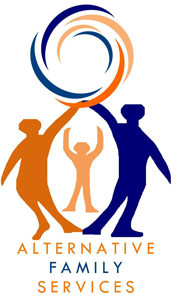
Alternative Family Services
Founded in 1978, Alternative Family Services (AFS) provides thoughtful, informed care, adoption and mental health services to foster children and youth throughout Northern California. The mission of Alternative Family Services is to support vulnerable children and families in need of stability, safety and wellbeing in their communities.
AFS, a COA-certified foster family agency, currently serves the diverse and varied needs of 1,500 foster youth, plus their biological and foster families, in the San Francisco Bay Area and Greater Sacramento Regions. Services provided by AFS include therapeutic foster care, Intensive Services Foster Care, support for foster children with developmental disabilities, therapeutic visitation, community-based mental health services, transitional housing support, independent life skills training, and much more.
Since we began taking huge societal steps to flatten the curve and address our current public health crisis, my inbox has been flooded with emails from what seems like every retailer and restaurant I have ever visited. Are they reaching out to alert me of the latest sales or entice me with a great deal? No. These businesses are reaching out to inform me about their individual response to the spread of COVID-19. These communications have included how they are adhering to state-specific closure orders, enhancing their hygienic practices, supporting the health and safety of staff, and pretty much anything related to changes brought on by measures to combat the spread of COVID-19.
Social service providing organizations, whether classified as essential or nonessential during this time, are no different in that they must strive to communicate with their stakeholders about how they are addressing COVID-19 as an organization. Across a single social service program, stakeholders can include clients, family members of clients, staff, volunteers, community members, funders, and board members. All of these stakeholders can be impacted in different ways by your COVID-19 response measures. Communicating clearly and specifically to individual groups of stakeholders will show them that your organization is taking the crisis and its role in protecting the community seriously.
COA has put together a list of references to assist your organization in navigating communication with your stakeholders during this time. We’ve organized the information below by:
- Developing a communication strategy
- Staff outreach
- Funding, media, and advocacy outreach
- Materials
- Guidance on reducing stigma
Our Interpretation blog is meant, first and foremost, to be a resource for the COA community. We are continually evolving its content to meet the needs of our COA network. If you have a resource, article, or tool that you’d like to see posted, we’d love to hear from you! Reach out to us by email at PublicPolicy@coanet.org.
Developing a communication strategy
The abrupt transitions required by COVID-19 has forced for-profit and nonprofits alike to rapidly address a myriad of issues, including communication with their stakeholders. Taking the time to develop a planned communication approach will ensure there is continuity and comprehensive information in your communications and will likely prevent time spent later answering questions. Harvard Business Review has published some helpful tips in developing your communication approach, beginning with the creation of the standing Pandemic Leadership Team. They have also examined the emergency communication responses of companies that have experienced crises previously.
- Harvard Business Review: Communicating Through the Coronavirus Crisis
Staff outreach
Whether your agency staff are considered essential or non-essential workers, it’s important to understand that they are impacted both professionally and personally by this crisis. Communications to staff should be sensitive to this by providing clear, concise, and accurate information. In addition, ensure staff are given a supportive and facilitative environment to ask questions and seek clarification. Workers are dealing with a myriad of concerns as a result of COVID-19. They’ll expect clear information regarding everything from individual health insurance coverage to expectations in work-from-home policies.
The Centers for Disease Control and Prevention (CDC) has created tools to assist employers in communicating about COVID-19 with their staff. In addition, Forbes has put together a survival guide to caring for staff in a remote environment that can help you craft internal communications during this time. How you communicate with staff during this crisis will dictate the office culture when you return.
- CDC: Prepare your Small Business and Employees for the Effects of COVID-19
- Forbes: Company Survival Guide To Care For Staff During The Coronavirus Pandemic
Funding, media, and advocacy outreach
Addressing the global public health crisis has led to an unprecedented global financial crisis. Legislators at the state and federal level are working hard to determine how best to support the economy while maintaining needed social distancing precautions.
The first federal stimulus package, the Families First Coronavirus Response Act, provided some of the financial aid needed by businesses and individuals. It is expected to be followed up with subsequent stimulus bills to continue providing meaningful aid. This means there will be additional opportunities for service providing agencies to advocate for inclusion in future relief packages. It is important that agencies are using any and all tools and connections they have to advocate for their stakeholders and raise awareness of the importance of their specific services in their community.
The Alliance for Strong Families and Communities (also known as the Alliance) has created a toolkit for their network to raise awareness about the importance of community-based human services organizations, which become even more vital in times of crisis. To also assist you in raising critical funds, this toolkit includes a national fundraising campaign with graphics and sample posts, as well as media outreach templates. Use these tools to leverage your visibility as part of the national Alliance network and raise awareness for your specific community impact and financial needs.
- Alliance for Strong Families and Communities – COVID-19 Fundraising and Media Outreach Toolkit
Materials
Communicating accurate and helpful information is the duty of all organizations addressing COVID-19 in their community. On-site, this can mean having materials available to service recipients. The CDC and the World Health Organization (WHO) have published a number of free resources for all businesses to use, including fact sheets, guidance, videos, and posters. By using the latest materials published by the CDC, you will ensure the information you are communicating is in accordance with current public health announcements and guidance. In addition, check your state’s public health and human service department’s departments websites to see if materials specific to your state are available to you. Below are links to current communication tools and resources available for use and distribution.
- CDC: Communication Resources
- CDC: Directory of state and territory health agencies
- WHO: Communicating the Risks of COVID-19
Guidance on reducing stigma
Stigma affects the emotional and mental health of those that the stigma is directed against. Stopping stigma is an important part of making communities and community members resilient during public health emergencies. Even if we are not personally involved with the stigmatized groups, it’s important to stay vigilant and address it when issues arise.
We hope you find these resources useful! Check out our other posts on COVID-19—COVID-19 Resources (Extended Version) and Preparing for Response to COVID-19,—for additional information.
What other helpful resources for managing communication during the COVID-19 outbreak have you seen? Share yours in the comments below!
Protect your clients, protect your staff, protect your organization, protect your community.
As the virus that causes COVID-19 continues to have a significant impact on our lives, accredited and in-process organizations have asked us how the standards can help them be ready and respond. In this post we will make a few big-picture recommendations about where to start with your preparations, then point out the key standards that might inform your response.
A few quick recommendations
Before we look at specific standards, we have a few recommendations. First, pull your senior staff and members of your governing body together to think about what your organization needs to do be prepared for and respond to the virus. We strongly recommend that you review the CDC’s Interim Guidance for Administrators and Leaders of Community- and Faith-Based Organizations to Plan, Prepare, and Respond to Coronavirus Disease 2019 (COVID-19). This resource is the single best resource we have seen to help you prepare your organization for the inevitable arrival of the coronavirus in your community. The guidance provided is specific and clear and is continually updated as new information emerges.
Second, review and update your emergency preparedness plan and other relevant polices and procedures. COA has several standards that address key preparedness and response issues that accredited organizations will already have in place. These fall under the broad standards categories of human resources management, safety and security, and emergency preparedness. More about these below.
With regard to service delivery: Depending on the types of services you provide and the populations you serve, you are very likely to get multiple communications from federal, state, and county oversight entities, as well as others with specific directives and/or guidance that will directly effect your work at the program level. You will want to merge these varying sources of guidance– some of these will be mandatory–into a form that staff can understand and follow.
It is important also to make this information easily accessible. One organization that serves the homeless mentally ill in upstate New York has been receiving updated virus-related directives from multiple sources almost every other day. Every time one of these is received, the CEO merges the new information into updated procedures and then walks around and replaces the old documents, which have been posted all over the facility, with the newest version. Staff are very busy and aren’t always able to stop what they are doing and check their email to see if new updates have been made to the online procedure manual. So put such critical information right in front of them.
Third, communicate clearly and openly with the people you serve, your staff, and the public. The situation in your locale may be changing quickly. Your clients and staff will be looking to you for guidance. Wild Apricot has a very good blog entry titled How to Create a Crisis Communications Plan for Your Nonprofit that you may find useful.
Communication also includes ensuring that staff know who to go to for answers in rapidly evolving situations. Anticipate that some staff who have decision making authority may become sick. Plan for that eventuality, and make sure that staff know who to go to in their place. This is especially important in larger, multiservice organizations who may provide a variety of different services in multiple locations.
Now lets take a look at some of the key COA standards. Currently accredited organizations will have policies and procedures related to these standards already in place. For these organizations, your task it to review these and update them where necessary.
Review and update your emergency response plan and procedures
Pull out your emergency response plan and procedures (ASE 6.01, ASE 6.02, ASE 6.03) and review them with COVID-19 in mind. If you are like many other organizations, you may not have anticipated a fast-moving pandemic when your plan was developed. Emergency response plans and procedures for multiservice organizations and those providing services at different sites may need to include location-specific guidance for each program site.
Things to consider:
- Clarifying who will communicate with authorities and emergency responders at each program location
- Clarifying and testing your lines of communication to staff, your board, clients, and the public
- Clarifying your responsibilities for persons served with mobility challenges and other special needs
- Do you have sufficient supplies at each site? (I.e. masks, gloves, hand-sanitizer, first aid, first aid manuals, cleaning supplies, disinfectant, toilet paper, food, maintenance supplies, batteries, etc.)
- Is emergency contact information up-to-date for all staff and service recipients?
- Will medications be available for people in residential facilities?
- Are copies of emergency response plans and procedures readily available to staff at all program sites?
- How will programs and administrative offices cope with multiple staff absences due to illness?
- If volunteers perform important functions, how will those functions be done if volunteers are prohibited from entering your program sites?
- How will your programs operate if absenteeism spikes?
Review and update safety and security measures
The standards in ASE 5: Safety and Security address the safety and security of your staff and persons served at your program and administrative sites. Review your most recent safety assessment and any measures that were implemented to address identified issues. Then conduct a new COVID-19 assessment if time permits.
Things to consider:
- Will you need to update or create a visitor policy? (I.e., will visitors be prohibited? Who will be allowed to enter your program sites?)
- Will staff and service recipients be permitted to congregate?
- Will face-to-face staff/client interactions be permitted? If so, under what conditions?
- How quickly can you train staff on updated safety procedures and protocols?
- If you run a residential program, are you capable of quarantining residents? If not, what happens with residents who are ordered to be quarantined? How do you promote/enforce social distancing in congregate care facilities?
Review and update human resource management policies
By the time you read this, many of you will already be under restrictions mandating the closure of all non-essential businesses. Although most of our accredited organizations will be not be subject to those restrictions, most have staff that do not necessarily need to be on-site to perform their jobs. Many of you are scrambling to put human resource policies in place to reflect this new reality. The standard HR 3.02 broadly addresses what may go into an HR policies and procedure manual.
Things to consider:
- Which jobs are critical to the organization’s continued operation? Which can be performed remotely, and which cannot?
- How will critical job functions be performed if key staff are absent due to illness or the need to care for family members?
- Do you have a remote working policy? How will supervision be conducted for remote workers?
- Do your sick time and leave policies reflect guidelines and mandates about virus-related sick time? Does your family-leave time? Do they encourage staff to stay home if they feel sick?
- Is your HR department staying abreast of the latest, rapidly-changing federal and state rules about insurance costs? Are you prepared to help staff understand how new rules apply to them?
Again, the CDC has good, comprehensive, practical guidance for employers: Interim Guidance for Businesses and Employers to Plan and Respond to Coronavirus Disease 2019 (COVID-19).
Review and update technology and information security for remote working
Remote working is as much a technological issue as it is a human resources management issue. The policies and procedures required for RPM 4: Technology and Information Management, and RPM 5: Security of Information should be reviewed and updated if you will be requiring some of your staff to work at home.
Things to consider:
- How will staff securely access work files from off-site?
- How will remote staff communicate with staff who are still working onsite? With each other?
Review and update policies and procedures for technology-based service delivery
The coronavirus has rapidly pushed technology-based service delivery from the periphery to becoming a core intervention modality for many kinds of social and human services. If you are already employing technology-based interventions, take this time to review new rules and guidance coming for the federal government on its use. Then review the standards in PRG 4: Technology-based Service Delivery to ensure that your current practices continue to meet the requirements of the standards.
If you are thinking about employing technology-based interventions for the first time, you need to understand that there are many important factors to consider, including confidentially, security, data collection and transmission, acceptable technologies, licensure, how to work with clients through electronic means, and more. A review of the standards in PRG 4 will give you a frame of reference for what such services look like.
We hope this post helps to bring some of the most important questions into focus for you as you prepare for the coronavirus. The function of accreditation is to build organization’s capacity and resilience through a careful and thorough review of its administration and service-delivery practices. It does this by having you look at what you are doing and how you are doing it, thinking about how you can do things better, and, finally looking ahead so you can be ready for what is coming, both seen and unforeseen.
Be safe.
In light of the ongoing coronavirus crisis, we wanted to highlight some of the resources that we provide on our website, and to provide additional ones, as well. Stay up-to-date on everything happening with COA during the pandemic here.
No matter what role you occupy in the social service delivery continuum, chances are that precautions in the face of COVID-19 have drastically changed the way you work in just a few short weeks. This rapid transition in our lifestyles has led to a deluge of information about how to cope and behave during this time, both personally and professionally. COA has put together a list of references to assist you and your colleagues in navigating all of this news and guidance. We’ve organized the information below by topic:
- General guidance from government agencies
- Guidance for child welfare providers
- Guidance for childcare providers
- Guidance for businesses and employers
- Guidance for healthcare professionals
- Guidance for community organizations
- Guidance on reducing stigma
The Interpretation blog is meant, first and foremost, to be a resource for the COA community. We are continually evolving our blog content to meet the needs of our COA network. If you have a resource, article, or tool that you’d like to see posted, we’d love to hear from you! Reach out to us by email at PublicPolicy@coanet.org.
General guidance from government agencies
It’s important to educate yourself on and follow the guidance of international, national, and local health organizations. The following organizations maintain a collection of resources and information on the spread of COVID-19. COA recommends locating the health agency of your state or territory to find information that is specific to your local community. In addition, make sure that you are signing up for available subscription/distribution lists, where information may be disseminated on an ongoing basis.
- From the World Health Organization (WHO): Coronavirus Disease (COVID-2019) Situation Reports
- From the U.S. Center for Disease Control (CDC): Coronavirus Disease 2019
- From the Canadian Department of Health: Coronavirus Disease (COVID-19): Outbreak Update
- Directory of state and territory health agencies
Guidance for child welfare providers
The US Children’s Bureau shared this letter with the agencies they oversee the in child welfare system. In addition to this letter, the Children’s Bureau is maintaining this webpage with resources related to COVID-19.
Organizations leading the field in child welfare practice and policy have also created resources to assist agencies in navigating service delivery during this time:
- From the National Child Traumatic Stress Network: Parent/Caregiver Guide to Helping Families Cope with the Coronavirus Disease
- From Generations United: COVID-19 Fact Sheet for Grandfamilies and Multigenerational Families
- From Prevent Child Abuse America: Coronavirus Resources & Tips for Parents, Children & Others
- From the National Association of Social Workers: Resources for Social Workers
In addition, The Chronicle of Social Change (now The Imprint) has redirected their reporting to focus on COVID-19 and have posted a number of stories on developments in the child welfare space. We recommend starting with Coronavirus: What Child Welfare Systems Need to Think About.
Guidance for childcare providers
Childcare providers have been deemed essential workers across many regions, even areas with the strictest social distancing regulations in place. This is because we need to ensure childcare is accessible to other essential workers during this time.
Guidance for businesses and employers
There is no doubt that concerns about and restrictions around COVID-19 are impacting how businesses are run. We’ve seen some guidance on how to bear out these changes here:
- From the CDC: Resources for Businesses and Employers
- From the US Department of Labor: COVID-19 Overview
- From the National Council on Nonprofits: The Nonprofit Community Confronts the Coronavirus
Guidance for healthcare professionals
Healthcare facilities are on the front lines of the COVID-19 pandemic. Find resources to help manage resources and protect yourself and your staff below.
- From the CDC: Resources for Clinics and Healthcare Facilities
- From the CDC: Resources for Healthcare Professionals
Guidance for community organizations
Community-based organizations will be integral to ensuring the infrastructure of community needs are able to be met during this time. Fortunately, there are COVID-19 tools available for organizations that serve vulnerable populations:
- From the CDC: Resources for Community- and Faith-Based Leaders
- From the CDC: Resources to Support People Experiencing Homelessness
The National Coalition for Homeless Veterans also has resources specific to each type of services provider they oversee:
- From the National Coalition for Homeless Veterans: COVID-19 Resources
Guidance on reducing stigma
Stigma affects the emotional and mental health of those that the stigma is directed against. Stopping stigma is an important part of making communities and community members resilient during public health emergencies. Even if we are not personally involved with the stigmatized groups, our voice can have an impact.
- From the CDC: Reducing Stigma During a Public Health Crisis
What other helpful resources for managing the COVID-19 outbreak have you seen? Share yours in the comments below.
Welcome to the Council on Accreditation (COA) blog post series Profiles in Accreditation!
The organizations that COA accredits are diverse in both the communities they serve and their reasons for seeking accreditation (or reaccreditation). Profiles in Accreditation will explore the accreditation experience through the perspective of these organizations. Through them, we can discover the value of accreditation, best practices, lessons learned, and recommendations.
Organization profile
Name: Ranch Ehrlo Society
Locations: Regina, Prince Albert, Moose Jaw, Fort Qu’Appelle, and the Rural Municipalities of Edenwold, Corman Park, and Buckland, Saskatchewan, Canada
First accredited: 1977
Reaccredited: 2019
Snapshot: Ranch Ehrlo, a non-profit organization, was founded by the late Dr. Geoff Pawson in 1966. It started as a single residential unit for six troubled boys and grew to a multi-service agency that serves thousands every year. Ranch Ehrlo offers a wide range of accredited mental health and developmental services on campuses located in and around Regina, Saskatoon, and Prince Albert, in the Canadian province of Saskatchewan. Its services include assessment and psychotherapy for members of the broader community, family treatment and reunification, early learning, vocational training, emergency receiving services, treatment foster care, affordable housing, residential treatment and education for children and youth with mental health and addictions needs, residential care for older adolescents and adults with pervasive and complex developmental disorders, and community recreation and sports programs for at-risk youth. Clients are referred to Ranch Ehrlo from across the country.
Ranch Ehrlo’s mission isto provide quality preventative and restorative services to, and advocacy for, vulnerable individuals and families through highly engaged and professional employees. Itenvisions communities where all individuals and families achieve their full potential.
Ranch Ehrlo is guided by the CARE model, Children And Residential Experiences: Creating Conditions for Change. Developed by Cornell University, CARE is a multi-level program aimed at improving services for children and youth in care. Based on six guiding principles (developmentally focussed, family involved, relationship based, trauma informed, competence centred, and ecologically oriented) the CARE model is designed to significantly influence the way professionals work with children.
Interview with Ranch Ehrlo Society
For this Profiles in Accreditation post, we asked Ranch Ehrlo President and CEO Andrea Brittin to share her experience of the COA accreditation process at a large organization that dedicated itself to becoming accredited not because of a mandate, but because of a passion for best practices. Ms. Brittin emphasized how accreditation has encouraged growth and enhanced cohesion across the agency.
* * *
COA: Why was seeking initial accreditation important for your organization?
AB: In the early 1970’s, Ranch Ehrlo Society sought to obtain accredited membership with the Child Welfare League of America (CWLA) to assist in the development of sound policies, procedures, and standards of practice. As the CWLA was one of the founding members of COA, it was a natural progression for us to seek accreditation from this body to validate our effectiveness and keep abreast of the latest in research and best practice.
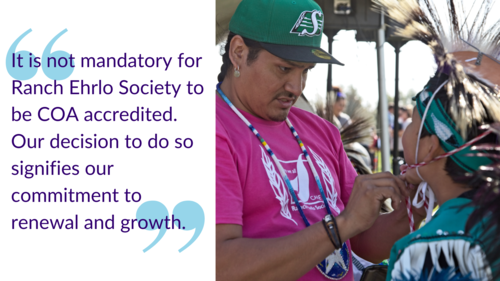
COA: What were some of the drivers for seeking reaccreditation?
AB: Ranch Ehrlo Societystrongly believes that maintaining best practice, as well as continual self-assessment, aids quality improvement and rejuvenates the agency. This benefits both those we serve and agency personnel. Undergoing the process of reaccreditation demonstrates that we, as an organization, continue to effectively manage our resources, allowing us to accomplish our goals. The reaccreditation process is one of many strategies we use to assist in stabilizing, measuring, and validating our effectiveness, ensuring that we are kept highly informed of the latest research and practice in the human services field. Our organization has grown exponentially since we were first accredited more than 40 years ago, so it is essential to have a method of review in place to be sure all elements are functioning smoothly.
COA: What about the COA accreditation process made you decide to partner with us?
AB: For clients and participants, COA accreditation demonstrates:
- Best practices carried out by appropriately trained staff.
- Client participation in their own service planning.
- A safe and respectful environment.
- Privacy protections of their confidential information.
- Positive outcomes.
- Cultural competence.
For employees, it demonstrates:
- Focus on health and safety with minimized risks.
- Efficient, effective, and supported environments. Defined professional staff qualifications. Performance evaluation and employee development in a culture of excellence.
For the board, it demonstrates:
- Sound financial management.
- Ethical practices.
- Current, relevant, and monitored strategic plan. Effective performance, quality improvement and risk management systems.
- Policies and procedures address pertinent issues.
For Funders and Referral Agencies, it demonstrates:
- Validation of high-quality services.
- Sound financial practices.
- Performance and quality improvement.
- Efficient organizational operations.
- Effective risk management policies.
COA: Were there any unexpected results after completing the Self Study and PQI process?
AB: We are very proud that COA standards and expectations have been engrained in the fabric of Ranch Ehrlo Society. New quality improvement initiatives, process developments, or procedure amendments are not undertaken “for COA”. These tasks are welcomed, as they are a testament to the value the agency places on continuous improvement. Although self-examination is not always simple, especially when obstacles are presented, the agency has learned to relish the challenge, with the solid best-practice framework and support COA offers. Comfort with self-reflection is an organizational shift from previous accreditation cycles.
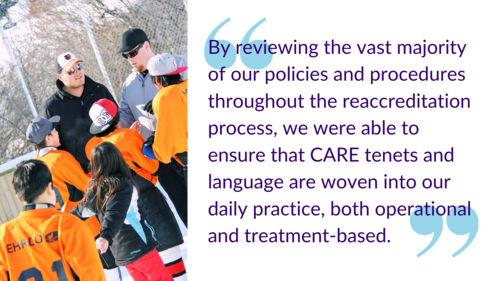
COA: How did you engage and communicate the value of accreditation to the entire organization during the accreditation process?
AB: A team of subject matter experts was appointed to each of the 21 sections/sub-sections of standards assigned to Ranch Ehrlo. These teams, in tandem with the quality improvement department, examined the standard implementation required and orchestrated the collection of evidence. This approach allowed investment in the process by a greater population of personnel.
Throughout the year leading up to the Self Study submission and Site Visit, communication to agency employees was ongoing. Emails, website stories, standing agenda items at departmental or program meetings, etc.–all worked simultaneously to ensure staff were informed and engaged.
All agency employees, regardless of position, program, or location, had the opportunity to partake in the process. There are various ways this occurred – from composing a written narrative, to offering input for policies in development, to being informally interviewed or observed during the Site Visit, to learning about the process through agency communications. This provided a sense of ownership in the agency’s intentions and functioning.
COA: What do you see as the main benefit of COA accreditation?
AB: We at Ranch Ehrlo strongly believe that adhering to best practices, as well as continual evaluation, helps us enhance our services for the young people, adults, and families we serve. For that reason (and many more), we choose to pursue accreditation as a means to periodically and thoroughly review EVERYTHING we do. It is not mandatory for Ranch Ehrlo Society to be COA accredited. Our decision to do so signifies our commitment to renewal and growth. COA offers extremely thorough training, documentation, and support throughout the process, so, although accreditation is a great deal of work, guidance was always available.
COA: What about the accreditation process do you feel was most valuable to your organization?
AB: The self-study process is always a valuable opportunity for reflective practice and learning. In the past, it has proven so impactful and valuable for staff to hear the comments of Peer Reviewers at the Exit Meeting, and to read about strengths and areas for improvement in the Final Accreditation Report.
Also, Ranch Ehrlo Society has been in the process of implementing the CARE (Child and the Residential Experience) Model of treatment over the last two years. All agency employees, regardless of role, tenure or location, have been or will be trained in the model, and continual training is offered to direct-care staff. By reviewing the vast majority of our policies and procedures throughout the reaccreditation process, we were able to ensure that CARE tenets and language are woven into our daily practice, both operational and treatment-based.
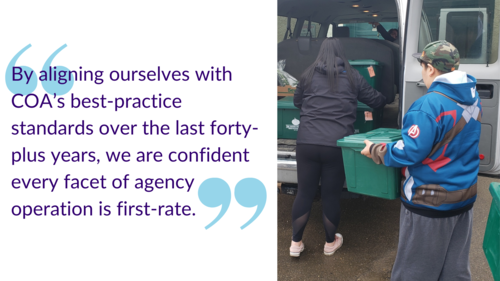
COA: What did you like most about the accreditation process?
AB: It is a collaborative process that requires numerous departments, programs and personnel to work closely to review policies and procedures and to evaluate the degree of standard implementation. By engaging collectively with colleagues, a cross-section of staff from a variety of areas were reviewing information, so processes were examined more thoroughly and under a variety of lenses. This led to a greater understanding and appreciation of the organizations’ functioning, allowing for enhanced cohesion.
The Site Visit was also extremely beneficial, as it provided real-time advice and feedback from the Peer Reviewers and gave employees a face-to-face connection with COA. The visit allowed us to demonstrate our successes, but we were also not afraid to have our challenges highlighted. This truly allows for reflective practice and growth.
COA: What was the biggest challenge during the accreditation process?
AB: Ranch Ehrlo Society is a large organization, with close to 900 employees working in dozens of programs and locations across the province of Saskatchewan. We were assigned 21 different sections of standards and submitted over 1000 documents for our Self Study. There was a great deal of organization and communication required to coordinate review teams and evidence.
COA: How has COA (re)accreditation impacted operational success?
AB: Ranch Ehrlo Society firmly believes that accreditation improves the overall quality of care for those we serve. By aligning ourselves with COA’s best-practice standards over the last forty-plus years, we are confident every facet of agency operation is first-rate. COA has given us the opportunity to strengthen our continuous improvement efforts and enhance our programming, while establishing a highly-competent workforce and supporting our mission. The process makes us more cognizant of proactively reviewing and, if required, revising policies and procedures and other agency operations.
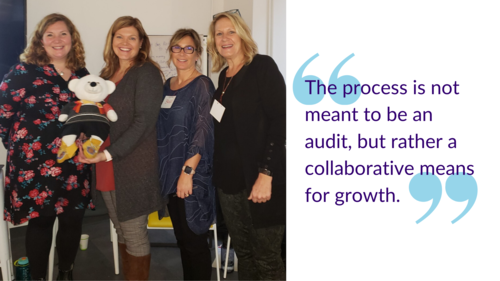
COA: What are the top three pieces of advice or tips that you would give to an organization considering or currently undertaking the accreditation process for the first time?
AB:
- Be sure to give yourself PLENTY of time to prepare for each phase of the process. Some required documentation or processes will already exist, but many others will have to be revised or created. Set due dates well in advance of final submission deadlines. It may take much longer than you anticipate preparing evidence and implement procedures. Carve out time in your daily calendar to complete COA-based tasks. This will keep you on schedule.
- Thoroughly review the standards prior to beginning the implementation review and document collection process, noting where information is required from a cross-section of departments. For example, the Residential Treatment Services Standards (RTX) may be the focus for employees working in those programs, but they will likely require collaboration with Human Resources for staffing lists, training information, etc. This will avoid scrambling for evidence when due dates approach.
- Depending on the size of your organization, the Stakeholder Survey process may be a much larger project-within-a project than anticipated. Collecting the contact information and engaging the assistance and input of hundreds of stakeholders across the country was a challenge for our agency.
COA: Are there any other learnings or insights that you’d like to share?
AB: Fully embrace the accreditation process. It is not easy, and it extremely time consuming, but it is all worth it in the end. Delve into the COA-offered trainings, both in-person and online and connect regularly with your accreditation coordinator with COA. The process is not meant to be an audit, but rather a collaborative means for growth in an organization. Do not be afraid to highlight areas of challenge or where improvement is required. That is the intention of the process. No organization is perfect, but accreditation can assist each organization in living up to their full potential.
Thank you, Ranch Ehrlo Society!
We would like to express our gratitude toward Ms. Brittin for her inspiring insights and tips and acknowledge the entire Ranch Ehrlo team for embracing accreditation and collectively contributing to the promotion of best practices. Thank you, all!
Do you have a COA accreditation story to tell? Click here to share it. You could be the next organization we feature!
Did you know? In our more than forty-year history, the Council on Accreditation (COA) has only had three logos—the most recent being the COA shield that launched in 2012 (which was an adaptation of a 2002 version). So, we thought with all the excitement surrounding our 2020 Edition standards, coupled with welcoming our new president and CEO, that the time was right to give our branding a refresh.
It was not something that we took lightly and many, many months of planning and design went into getting it just right. We wanted to make sure that we were remaining true to our roots, but elevating the look and feel to be more fresh, modern, and meaningful.
Welcome to the new COA!

Behind the logo
The logo focused on two key areas: the mark and the color palette.
The mark is now a more abstract symbol, shifting the focus from us and refocusing priority on the work and the organizations we support. If you look closely, you will notice that the ribbon—a symbol of achievement and excellence—is comprised of the letters C-O-A. This is meant to evoke feelings of pride and is open to individual interpretation. Some see a doorway or hallway, signaling a journey, process, or movement—much like our accreditation process itself.
Color your world

We utilized color theory to help us find the perfect palette that would not only be pleasing to the eye, but also rich in meaning and emotion. We landed on a light blue to purple gradient, which adds excitement and a sense of modernity…but there is so much more to it. Purple, a non-dominant color, signifies mastery and excellence, but also compassion. Blue evokes feelings of trustworthiness, wisdom, serenity, peace, and security. Combined, they perfectly convey our mission and purpose, while representing strong ties to our founding organizations and service areas.
Engage. Empower. Evolve.

We have also, for the first time, incorporated a tagline into the mix: Engage. Empower. Evolve. This tagline is a nod to our past while looking towards the future.
Engaging organizations as partners is a fundamental part of our DNA. We empower organizations to be efficient and effective so they can provide best-in-class services to the clients and communities they serve. Accreditation is also not a final destination or an end to a means. It’s an evolution. We continually push organizations to evolve and improve.
So, when you put it all together, the tagline truly speaks to our approach to organizational accreditation. Not to mention alliterations are fun!
Extra, extra! New credentialing seal
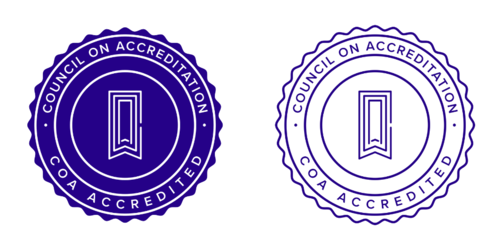
We realize achieving accreditation isn’t easy—it’s a true accomplishment. We wanted to give organizations a way to signal that they are COA accredited and show off their hard work and commitment to excellence. That is why we developed a special credentialing seal for accredited organizations use as a beacon of their accomplishment (rather than just using our logo).
The seal can be used across all organizational collateral (business cards, letterhead, e-mail signatures, etc.). Accredited organizations interested in learning more about acceptable use can request our new promotional toolkit, which we’ll link to on the launch of our new website.
Thank you
Thank you for being part of the COA community. We hope you are as excited by our new look as we are! Please excuse any materials with our previous logo that you might come upon as we work on getting everything switched over; we are working hard to get the updates your way.
Should you have any questions regarding the use of the seal or COA logo, please do not hesitate to reach out to Kelsey Risbrudt at krisbrudt@coanet.org.
Welcome to the Council on Accreditation (COA) blog post series Profiles in Accreditation!
The organizations that COA accredits are diverse in both the communities they serve and their reasons for seeking accreditation (or reaccreditation). Profiles in Accreditation will explore the accreditation experience through the perspective of these organizations. Through them, we can discover the value of accreditation, best practices, lessons learned, and recommendations.
Organization profile
Name: Rose Brooks Center
Location: Kansas City, Missouri
First accredited: 2018
Snapshot:Rose Brooks Center is a domestic violence agency serving the Kansas City Metro-Area. Its mission is to break the cycle of domestic violence so that individuals and families can live free of abuse.
Rose Brooks Center services include a 24 hour crisis hotline; a 100-bed emergency shelter for adults, children, and their pets; individual and group therapy services; a supported recovery program; advocacy services co-located within 5 hospital systems, civil and criminal courts, and the police department; a rapid re-housing program; residential and non-residential case management services; employment and economic advocacy; a school-based violence prevention program serving over 30 local schools; and community training and education.
Interview with Rose Brooks Center
For this Profiles in Accreditation post, we asked Chief Operating Officer Lisa Fleming to share her experience heading up the accreditation process at an agency becoming accredited for the first time. Lisa emphasized how accreditation has enhanced Rose Brooks Center’s quality improvement and risk management processes, and how the hard work of the Self Study can pay off.
COA: Why was seeking accreditation important for your organization?
LF: For several years, Rose Brooks Center had the goal of obtaining accreditation in our strategic plan. We were fortunate to have a local funder, the Jackson County Community Mental Health Fund, that offers agency capacity-building grants for improving mental health outcomes. Specifically, they provide funding to grantees to pay for accreditation fees. Since the early 90’s, the Mental Health Fund has provided Rose Brooks Center with leadership and guidance in using outcome data and quality assurance indicators to make improvements to our funded programs. Their capacity-building grant helped to ensure we moved to the next level of fully implementing best practice standards and building out our quality improvement process.
We recognized that accreditation would be the next step for ensuring quality services. It would also be important to sustaining a culture of quality improvement. While we had general policies and procedures in place for agency operations, we knew we would benefit from the structure and researched best practice standards offered by COA.
In addition, we have benefited from the institutional knowledge of several agency leaders who have been here for twenty or more years. As we planned for the next five to ten years, we knew that there needed to be a way of transferring this institutional knowledge and formalized processes for ensuring quality.
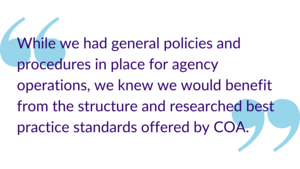
COA: What about the COA accreditation process made you decide to partner with us?
LF: There were several factors that influenced our decision to partner with COA. First, the COA process includes standards specialized for domestic violence services and emergency shelter operations. These standards reflect guiding principles of trauma-informed care and the standards set forth by our state domestic violence coalition.
Two of our local domestic violence agency partners had also selected COA and highly recommended COA. We benefitted from their lessons learned and work product as we conducted our Self-Study. We hope to pay it forward to another domestic violence program considering COA.
The consultation with our Accreditation Coordinator was a benefit that was not originally factored into our decision, but certainly was one that was extremely helpful and valuable to our self-study process. We always highlight this service to other agencies who are in the process of selecting an accreditor.
COA: Were there any unexpected results after completing the Self Study and Performance and Quality Improvement (PQI) process?
LF: The level of staff participation throughout the Self Study and ongoing PQI process has exceeded our expectations. It has been a valuable and effective way to instill a culture of improvement throughout the agency, and it has offered a professional development opportunity for staff who have an interest in program management. Recently, a PQI Team member expressed her interest in being a full time PQI Coordinator if the position was ever created. It was a result affirming our original goal of sustaining a culture of improvement.
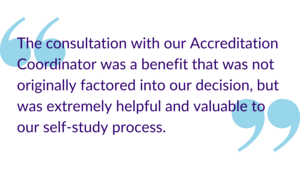
COA: How did you engage and communicate the value of accreditation to the entire organization during the accreditation process?
LF: We used many of the Intensive Accreditation Training and Performance and Quality Improvement Tool Kit documents to train staff, agency leadership, and the board. At our first staff training we used the Culture of Improvement document, and staff shared examples of Rose Brooks Center practices that supported each component of a culture of improvement. The activity and document helped connect staff to the things they do on a regular basis but may not have considered to fit with the more formal definition of Performance and Quality Improvement. We did a similar presentation with our board to share the benefits of accreditation, explain the self-study process, and train on the new or updated policies and procedures.
COA: What do you see as the main benefit of COA accreditation?
LF: COA accreditation sustains a foundation of research-based best practices throughout our organization. This helps to ensure that our agency achieves our intended outcome goals, exceeds our indicators for service delivery quality and safety, and manages agency operations with the highest degree of ethical and fiduciary standards. The accreditation process and resulting new or updated policies and procedures continually inform and guide our program development and improvement, training and professional development, risk prevention and management activities, and overall agency capacity building activities.
COA: What about the accreditation process do you feel was most valuable to your organization?
LF: Establishing routine and formalized processes for agency-wide performance and quality improvement and risk prevention and management that will be sustained long-term. Concurrent to the self-study process, our agency has continued to work on succession planning and staff professional development. Several staff with over 20 years of institutional knowledge will retire within the next 5 to 10 years. The accreditation process has been incredibly effective in transferring the institutional knowledge, expertise, and processes that have resulted financial stability and quality services to the next generation of leaders.
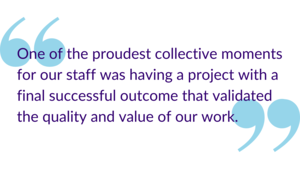
COA: What did you like most about the accreditation process?
LF: One of the proudest collective moments for our staff was having a project with a final successful outcome that validated the quality and value of our work. Seeing the volume of evidence describing all that staff do on a daily basis was a pretty great feeling.
We appreciate having the researched-based standards offered by COA, as well as the flexibility and empowerment to create agency procedures that can both fulfill the requirements of the standards and be customized to meet the unique needs our workforce and the people we serve.
COA: What was the biggest challenge during the accreditation process?
LF: Managing a full time position while working a project that could in itself be a full time job position. It’s worth it. But it’s a lot. Thankfully, I had a great team of supervisors and staff to help with the project. We also appreciated the help from Sabrina (our Accreditation Coordinator) in determining a reasonable timeline for completion.
COA: How has COA accreditation/reaccreditation impacted operational success?
LF: COA accreditation has formalized our Performance and Quality Improvement (PQI) and risk prevention and management processes. In turn, we have been able to include these up-to-date recommendations and improvement needs into multiple grant proposals. The monitoring and improvement processes provide our grant writers with timely, detailed, and substantiated Statement of Need for a wide variety of local, state, federal, and foundation grants. We have been awarded funding for program enhancements, staff training, equity and inclusion consultation services, facility and security improvements, and client supplies using PQI and risk prevention and management data.
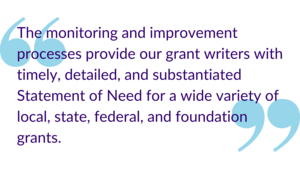
COA: What are the top three pieces of advice or tips that you would give to an organization considering or currently undertaking the accreditation process for the first time?
LF:
1. Use the tools, documents, training, and consultation offered by COA. Our monthly meetings with our Accreditation Coordinator, Sabrina, were extremely helpful to increasing our understanding of the standards and thinking through what needed to be developed or what existing procedure could be adapted to fit with a standard. They were also a reassurance that COA’s goal was to help us successfully achieve accreditation.
In addition, I would also recommend sending the staff person with the primary responsibility for coordinating the self-study to the in-person Intensive Accreditation and the Performance and Quality Improvement training offered by COA.
2. Reach out to another similar agency who has gone through COA’s self-study and site visit process. Most are very willing to share their policies and procedures. It can really help you get past a “writer’s block” and get you started. Likely they can help re-assure you about the process and its benefits.
3. Designate a leader and a team that has an expansive and detailed knowledge of agency operations to coordinate the self-study process. At first we hired a consultant to do the coordination, but the volume of concurrent projects, processes to be developed, and constant communication proved challenging for an external position. For our agency, it worked best to have the COA Coordinator (our Chief Operating Officer) develop a timeline and document checklist using the COA tools. The COA Team, comprised of program directors and the Executive Team, met at least monthly to review progress. Program directors involved their team members to update or create program-specific procedures.
COA: Are there any other learnings or insights that you’d like to share?
LF: Personally, the self-study process was one of the most challenging projects I have worked on in my 28 years at Rose Brooks Center. It is also one that I take the most pride in having led. As an Executive Team, it has given us increased confidence that the culture of improvement and our commitments to safety, quality, trauma informed- care, and equitable and inclusiveness will be sustained.
Thank you, Rose Brooks Center!
We would like to thank Lisa for her thoughtful insights into the first-time accreditation process and acknowledge the entire Rose Brooks Center board and team for embracing accreditation and collectively contributing to the promotion of best practices. Thank you, all!
Do you have a COA accreditation story to tell? Click here to share it. You could be the next organization we feature!
Welcome to the Council on Accreditation (COA) blog post series Profiles in Accreditation!
The organizations that COA accredits are diverse in both the communities they serve and their reasons for seeking accreditation (or reaccreditation). Profiles in Accreditation will explore the accreditation experience through the perspective of these organizations. Through them, we can discover the value of accreditation, best practices, lessons learned, and recommendations.
Organization profile
Name: Family Service Association
Location: Lincoln, Nebraska
First accredited: 1998
Latest reaccredition: 2019
Snapshot: Family Service is a nonprofit organization that has been providing services to the families of Lincoln, Nebraska for 125 years. They recently updated their mission to be “Helping Families Thrive.” Currently, Family Service provides families with four programs: Women, Infants, and Children; Child Care Food; Behavioral Health; and Out-of-School Time, which includes before- and after-school care, as well as summer care.
Two of Family Service’s four programs are accredited with COA: Behavioral Health and Out-of-School Time. Their Out-of-School Time program is their largest program. It consists of 14 before- and after-school care programs and seven Community Learning Center programs. Their Behavioral Health program provides licensed therapists to 22 schools within Lincoln Public Schools and six schools in Saunders County. It also includes of a Community Response Program, which connects families with community resources that will support families to meet their goals and strengthen relationships within the community.
Interview with Family Service Lincoln
For this Profiles in Accreditation post, we asked Director of Strategic Initiatives Jessica Radford, Ed.D. to share her experience at an organization that has been accredited by COA for the last ten years. Jessica told us how reaccreditation has helped drive the organization’s quality improvement forward. She also shared how she appreciated how COA accreditation felt not like an evaluation via checklist, but an effort from a team.
COA: What were some of the drivers for seeking reaccreditation this latest time around?
JR: It was important for our organization to seek reaccreditation to learn how quality programs and services are defined and to help us identify areas of growth. All our Management Team was new within the past two years. Reaccreditation provided us with the opportunity to really dig into the organization and its practices. We learned what was done historically, what was currently being done, and how we could improve it.
Accreditation helped us to evaluate and update practices that are oftentimes overlooked. Some of these included safety and risk assessments, HR audits, and an annual review of policies and procedures. It also helped us evaluate our system for communicating with staff and involving stakeholders. Sometimes we forget to evaluate our common organization practices and their effectiveness because we just keep doing things the way they’ve always been done. Accreditation helped us hone in on these practices and improve them.
COA: What about the COA accreditation process made you decide to partner with us?
JR: Our organization has been accredited with COA for the last ten years, and the staff take great pride in this accreditation. COA holds their organizations to high standards and has a rigorous accreditation process. So it was important for Family Service to continue this accreditation with COA for consistency, as well as to ensure we were providing good services to employees and families.

COA:How did you engage and communicate the value of accreditation to the entire organization during the accreditation process?
JR: We held a kick-off meeting where we brought everybody together and talked about the importance of accreditation, the process, and the role they would play. We provided updates through emails and meetings. When we received our accreditation, we had a cookie celebration and invited the board and stakeholders.
COA:What do you see as the main benefit of COA accreditation?
JR: The main benefit for us through our COA accreditation was the framework for evaluating and improving the organization and its practices. Sometimes it can feel overwhelming, not knowing where to begin with improvements or trying to identify what needs to be improved. COA provided a very thorough framework for us to follow, allowing us to assess the organization and its practices comprehensively so that we could target areas to work on. The standards also provided guidance for how to make improvements and what best practices are for nonprofit organizations.

COA: What about the accreditation process do you feel was most valuable to your organization?
JR: All of it. 😊
The standards were easy to understand and provided clear guidance. The staff at COA were very responsive and helpful. They always responded within a day anytime I emailed or called them, and they always had an answer for me. They were also very willing to take the time to help me and make sure I understood the process and standards.
The feedback given to us from our on-site reviewers was also very valuable and appreciated. For example, the on-site reviewers talked with us about the training of the organization. Following this conversation, we purchased an online training system and began implementing it. The system communicates with staff, tracks training completion, and provides lots of training options to staff.
COA: What did you like most about the accreditation process?
JR: I liked all the guidance that was provided through the accreditation process. The standards were very easy to understand and provided lots of explanations through the Interpretations. The staff at COA were so knowledgeable and helpful. The Intensive Accreditation Training was full of great information and guidance. Our on-site reviewers provided lots of great feedback on areas we can improve. The process really felt like a team effort.

COA: What was the biggest challenge during the accreditation process?
JR: Organizing all the evidence. 😊
I found it helpful to organize the standards and evidence into tables. I put together tables with three columns: Standard, Required Evidence, and Family Service Evidence. This helped me to keep track of what document went with what standard and to be sure I provided evidence for each of the areas of Required Evidence. It helped me organize it into more of a checklist.
COA: How has COA reaccreditation impacted operational success?
JR: The reaccreditation has really helped drive our quality improvement forward. It has given us specific areas to improve on and helped us set goals and objectives. It’s only been a few months since we received our accreditation and we have already made some great improvements.
Because of our accreditation, we have worked to improve the training we provide our employees. We have created an onboarding process which includes some safety trainings and some behavior trainings. We have created an annual training plan which includes monthly safety trainings for all staff and bi-monthly supervision trainings for all supervisors. The system we have implemented tracks trainings completed by staff in one on-line system. This has helped us to keep track of trainings as well as identify training needs for staff. This has not only improved our training program, but also the culture at our organization. Staff now feel that safety and training is a priority to Family Service.
We have also become more aware and thoughtful about reviewing our practices on a regular basis. We have implemented annual HR audits, stakeholder meetings and surveys to get feedback on our programs, annual reviews of policies and procedures to make sure they reflect what we are doing, quarterly safety checks and risk assessment reports, and improved data collection to help us analyze practices and programs.

COA: What are the top three pieces of advice or tips that you would give to an organization considering or currently undertaking the accreditation process for the first time?
JR: The coordinator of the process needs to be a very organized person. A large part of the process is collecting and organizing evidence to be submitted. If the person is already good at organizing projects and information, setting deadlines, and delegating duties, this will make the process less overwhelming.
Use your COA team. Do not be afraid to ask questions. Everybody on our COA team was so helpful. It felt more like a team effort instead of an evaluation and checklist.
Use the process as an opportunity to identify areas of growth. Do not try to look perfect for COA. Be honest about your practices and procedures. This will help you use the process to identify areas of growth and make improvements.
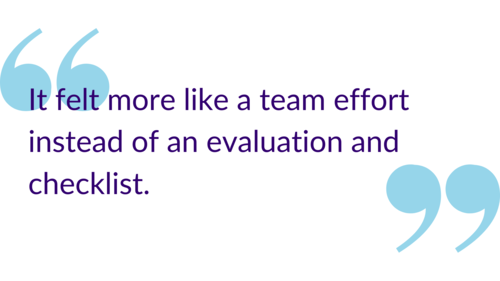
COA: Are there any other learnings or insights that you’d like to share?
JR: I cannot say enough good things about our accreditation team. Mary Glenn was amazing, and I couldn’t have done it without her. She was always so helpful and knowledgeable. Even when I felt overwhelmed or like we were doing things wrong, she helped guide me and reassure me that we were on the right track with things.
Our on-site reviewers were so pleasant and knowledgeable as well. They did a wonderful job at the introductory meeting explaining accreditation and the process to our board and staff. All our staff enjoyed having them on site and talking with them. Their feedback during the exit meeting was so valuable as well. It really gave us areas to improve on.
When we received our final accreditation report, nothing was a surprise because everybody had been so transparent through the process. It was really a team effort to get our accreditation, and COA was a big part of that team.
Thank you, Family Service Lincoln!
We would like to thank Jessica for her thoughtful insights into the reaccreditation process, and acknowledge the entire Family Service Lincoln board and team for embracing accreditation and collectively contributing to the promotion of best practices. Thank you, all!
Do you have an accreditation story to tell? Click here to share it. You could be the next organization we feature!
I’m going to go out on a limb and say it: Mental Health is IN right now. Everyone from meme accounts to rappers is talking about it, and working on your emotional well-being no longer has the same taboo it once did. In fact, some might go so far as to say that your emotional health is intertwined with your physical health (and those of us in the human services field are probably nodding our heads vigorously at this one). Then it follows to reason that if both aspects of our health are equally important, they deserve equal insurance coverage. But is that what’s happening?
Like most things in the world of behavioral health, the answer is….kind of. In 1996, the Mental Health Parity Act was signed into law. It dictated that the annual or lifetime dollar limits in health insurance coverage be equal to medical and surgical benefits. Did this happen? Short answer, no. Long answer, insurers continued to lead policy and utilized the levers at their disposal to reduce costs and ultimately limit coverage. Employers and insurers began to put a larger emphasis on cost sharing, limits and caps on the number of visits with a care provider or number of days in a hospital were imposed, and benefits didn’t extend to substance use treatment. This led to the 2008 passage of the Mental Health Parity and Addiction Equity Act (MHPEA), which gave advocates hope that further protections were being put in place to ensure equal coverage for behavioral healthcare. So now that it’s 2019, are we actually seeing parity?
MHPAEA 10+ years later
Reflecting on the decade-plus since its passage, what has the MHPEA done for health care coverage? The act has done several important things: it made sure that substance use treatment was included in the parity conversation, it protected mental health and substance use services from being subject to more restrictive cost-sharing and treatment requirements, it ensured equitable coverage for out-of-network treatment, and it gave patients the right to request information regarding medical necessity determinations and reasons for coverage denial. Despite these important steps forward in the battle for parity, implementation hasn’t been easy. Behavioral health providers are seeing 17-20% lower reimbursement rates than their medical counterparts, and the oversight varies wildly from state to state. Advocates such as Angela Kimball from the National Alliance for Mental Illness applaud the Federal law for paving the way for the removal of many of the traditional barriers to mental health treatment, but still feel “much more subtle discriminatory practices” remain an issue.
The “much more discriminatory practices” are what experts refer to as non-quantitative treatment limitations, which includes differences in how plans enact utilization management and define medical necessity, separate deductibles and co-pays for behavioral health services, limited options for in-network behavioral healthcare providers, and lower reimbursement rates. According to the Milliman Research Report on parity laws, this has resulted in decreased reimbursement rates for these provider’s services and approximately 32% of patients going out of network for treatment (in comparison to the 6% of patients that go out of network for their medical services).
Parity at the state level
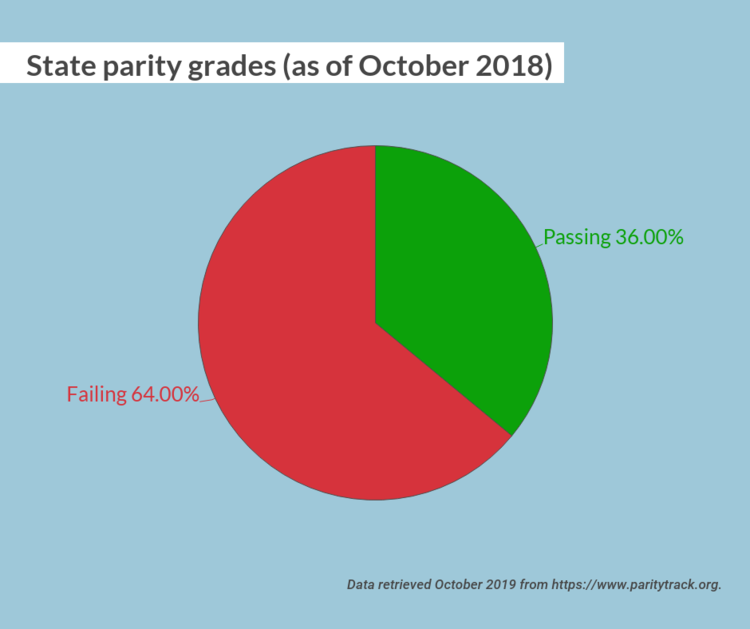
One major road block was inconsistent oversight and implementation at the state level. As recently as October 2018, 32 states received a failing parity grade. However, the state of Illinois was a star pupil, with a 100/100 grade. Illinois went above and beyond Federal parity policy by passing Public Act 99-480, which expands upon the MPHEA with provisions to extend coverage, provide education to the public about their rights, require minimum treatment benefits, and strengthen oversight and enforcement of the law. The Illinois statute extended applicability to plans not covered under the Federal parity law, such as fully insured plans for small employers and state and local governmental plans. It also extended the opioid antagonists covered in the plan. In addition, the legislation required the Illinois Department of Insurance to develop a plan for a consumer education campaign on mental health and addiction parity in order to help consumers, providers, and health plans better understand parity under the law. Finally, the law created an interagency workgroup and clarified the enforcement authority as the Department of Insurance. It’s this last piece, the interagency workgroup and clarification of enforcement, that promises continued success for Illinois parity. It promotes continual work, reflection, and analysis of Illinois’s parity statutes and clear delegation of responsibility.
The state of New York is an example of a state who has struggled with parity implementation but is actively trying to bolster its own Mental Health Parity laws. The Mental Health and Substance Use Disorder Parity Reporting Act was signed into law on December 22, 2018, and creates a reporting mechanism for health plan information to the Department of Finance to increase oversight of behavioral health management companies. The insurers will submit data to the department in order to keep track of potential non-qualitative treatment limitations. This is an important first step to identifying bad insurance coverage policy and protecting consumers.
Illinois and New York aren’t the only states who are working towards true parity for behavioral health coverage. Pennsylvania has identified and fined a large insurance company and its subsidiaries for imposed behavioral health treatment, and Wyoming and New Jersey both recently enacted policy for insurers to meet MHPAEA requirements. While the United States might not be at a point where we can safely say we are full parity across the nation, states are taking the steps to get there.
What can I do about health parity?
Glad you asked! For starters, call your legislators! The following states have introduced model parity legislation; contact your state senators and representatives to let them know you want them to support health parity: California, Florida, Maine, Massachusetts, Minnesota, Mississippi, Missouri, Montana, and Nevada.
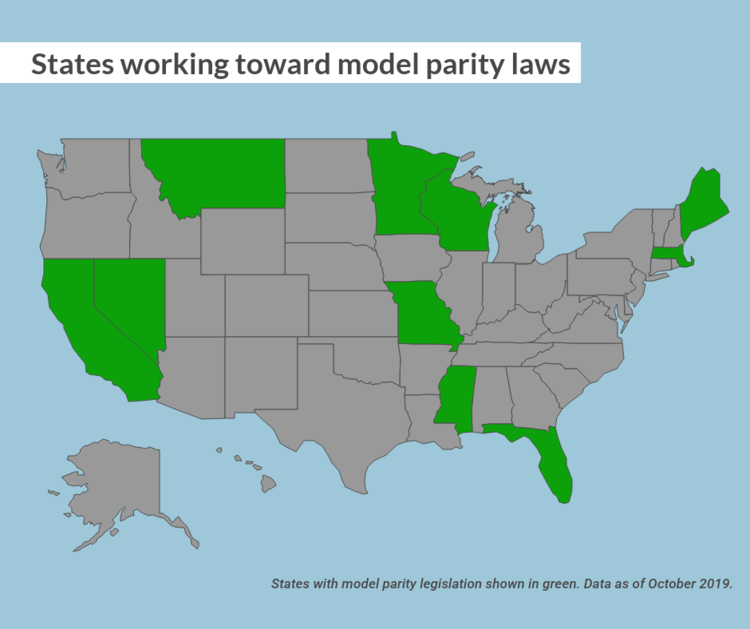
Don’t see your state here? The American Psychiatric Association has you covered with model parity laws for every state!
At the Federal level, there are several bills that could use your support. Contact your senator or house representative and let them know you support the following bills:
- The Mental Health Parity Compliance Act (S. 1737/H.R. 3165)—This would require comparative analyses about the design and application of managed care practices. That information would then be collected by federal agencies, who would analyze the plans’ compliance, specify what must be done to bring it into compliance, and submit an annual report of their findings.
- Parity Enforcement Act (H.R. 2848)—This bill authorizes the Department of Labor to issue monetary penalties for those violating the federal health parity law.
Reach out to your senators and representatives! Make sure that your state is providing you the best behavioral health coverage possible. Your mental health is just as important as your physical health, and it should be covered. The MHPAEA was an important step in the fight for parity, but we are a decade out from its passage and have learned lessons about the act’s limitations. We should be using those learnings to get us closer to full parity.
